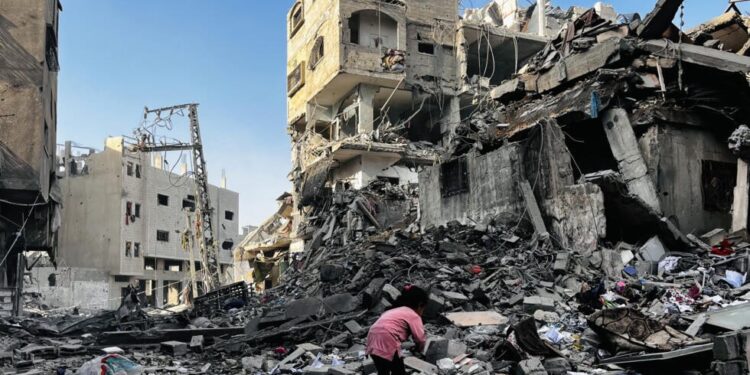Medical staff and emergency services say those killed in the attack include many women and children
Scores of Palestinians, including many women and children, have been killed in an Israeli airstrike on a crowded block of flats in the Gaza town of Beit Lahiya as Israel pressed on with its intense weeks-long assault on the north of the coastal strip.
Gaza’s civil defence agency said 93 people had been killed and 40 were still missing, with many of the victims members of the extended Abu Nasr family, as well as Palestinians displaced from elsewhere. The US State Department spokesperson Matthew Miller called the strike “a horrifying incident with a horrifying result”.
Mohamed El-Azamy, 34, who has been displaced more than 15 times in the past year, was in a building close to the one targeted. “Last night was one of the worst nights I’ve been through during this war,” he told the Guardian. “There was bombing from all directions. We were awake and waiting for that shell or missile that would crush our lives until half past four in the morning when our neighbours’ building was bombed.
“The scene was horrific. Most of the [victims I saw] were children. The corpses were mutilated. What hurt my heart the most was the sight of the children’s bodies that were collected and placed on the side of the road, their clothes were torn and grey because of the rubble.”
The latest incident involving large-scale civilian deaths came as the UN’s World Food Programme [WFP] called for immediate action to avert famine, warning that the situation in northern Gaza “continues to deteriorate, the likelihood of a larger group being impacted by famine will surely increase”.
The US ambassador to the UN, Linda Thomas-Greenfield, said Washington rejected “any Israeli efforts to starve Palestinians in Jabaliya, or anywhere else” in the Gaza Strip. “Israel’s words must be matched by action [on humanitarian aid] on the ground. Right now, that is not happening. This must change – immediately,” she told the security council.
Tuesday morning’s strike was launched barely hours after Israel’s parliament passed two laws that could prevent the UN agency for Palestinian refugees, the largest aid provider in Gaza, from operating in the Palestinian territories. It marks the culmination of a long-running campaign against Unrwa, which Israel contends has been infiltrated by Hamas, an allegation the agency denies.
In the immediate aftermath of the strike workers and neighbours were confronted by scenes of horror as they dug through concrete rubble. The remains of victims were wrapped in blankets and lowered by rope from a balcony to be laid on the bloodied ground. Limbs poked out through chunks of dusty masonry and twisted wire.https://interactive.guim.co.uk/uploader/embed/2024/10/archive-zip/giv-45597u6Rn4220Wj0
The dead included a mother and her five children, some of them adults, and a second mother with her six children, according to an initial casualty list provided by the emergency services.
Video footage of the strike posted on social media showed bodies wrapped in carpets and blankets on the ground outside the building, while the sound of Israeli drones was audible above the site.
Ramez Rizk, aged 45, was close to the building that was hit. “Where we were was filled with the smell of gunpowder and the last window of the house was broken from the force of the strike, but luckily none of my family was injured.
“The people of the neighbourhood gathered and began removing the bodies, collecting the remains, and transporting the wounded to Kamal Adwan hospital, even though it was besieged and had no services. There are still bodies buried under the rubble, the rest of the bodies that were removed were transported on donkeys and horse carts to be taken to cemeteries.”
Dr Hussam Abu Safia, the director of the nearby Kamal Adwan hospital, where a number of medics were detained during a raid by Israeli troops last week, said dozens of wounded people had arrived at the overwhelmed facility. “The healthcare system has completely collapsed,” he said, adding that people who arrived wounded died because there was no way to care for them.
The Israel Defense Forces said they were looking into the reports of what had happened at the building.
Israel’s latest major operation in northern Gaza, focused in and around the Jabaliya refugee camp, has killed hundreds of people and driven tens of thousands from their homes in another wave of mass displacement more than a year into the war.
Israel has sharply restricted aid to the north this month, prompting a warning from the US that failure to facilitate greater humanitarian efforts could lead to a reduction in military aid.
The continuing violence in northern Gaza has played out against a background of Palestinians’ fears that Israel is enacting a plan proposed by a group of former generals to order the civilian population of the north to evacuate, cut off aid supplies and consider anyone remaining as a militant.
The military has denied it is carrying out such a plan, while the government has not said whether it is carrying out all or part of it.https://interactive.guim.co.uk/uploader/embed/2024/10/archive-zip/giv-455988f5YiwHCzq7
Thomas-Greenfield’s comments regarding “starvation” came after the US told Israel in a letter on 13 October that it must take steps within 30 days to improve the humanitarian situation in Gaza or it could face restrictions in US military aid.
Thomas-Greenfield said earlier this month that Washington was watching to ensure Israel’s actions on the ground did not show it had a policy of starvation in the north.
Source: The Guardian


Recent Comments